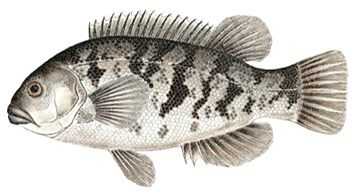Tautog

Species Details
Tautoga Onitis
Labridae
Perciformes
rocky outcrops, boulders, jetties
1 - 3 lbs.
1" - 36"
Description
Also known as the Blackfish, the Tautog is a species of wrasse (a family of fish known for being multi-colored) that is more prominently found in South Carolina and Nova Scotia. The Tautog is known for its mottled skin (having smears and spots) and being stout in build. This fish has thick fins and strong teeth. But some have noted that the Tautog also have a habitat in Chesapeake Bay in Maryland, Virginia. Others have noted that the one they call “Blackfish Heaven” is in Long Island. The Tautog has thick, squared fins, and has a dorsal fin with 16 spines. It also has a preference for structured habitats in saltwater areas.
Diet
Like most of their wrasse cousins, they are considered “carnivorous” but feast more on marine invertebrates rather than attacking humans. The Tautog prefer a diet of clams, crabs, barnacles, and mussels. The Tautog’s teeth are built in a way that allows them to crush shellfish easily. And since shellfish are commonly around rocks, the Tautog have rubbery skin that is coated in slime. This prevents them from being cut up by the rocks while they hunt for their prey. Once their jaws lock onto their prey, they have an extra row of teeth in their throat which allows them to further grind the shells for easier digestion.
Size
On average, adult Tautog can weigh as heavy as 1 to 3 lb (0.45 to 1.36 kg). Currently, the maximum size of a Tautog is at 3 ft (0.91 m) and 28.8 lb (13.1 kg).
Interesting Facts
When the Tautog fish feed, they prefer feeding in the day time. At night time, the Tautog are so inactive that they just lie on their side. Because of this, people actually might have a better chance of catching a Tautog at night at the cost of having no light. Like any other animal, the Tautog may have strong photosensitivity that using light will make it perceive that it’s during the day which may make any angler lose their chance.
Despite humans not being their main target, it does not mean that the Tautog are not aggressive. The Tautog are quite territorial and only choose to leave their habitat if the seasons are slowly changing into winter. All the more they become territorial around late April to early August. During the span between the two months, the Tautog begin to reproduce. A female Tautog produces approximately 200,000 eggs. The larvae of the Tautog then drift the shallow seabed and mature in 3-4 years. And one way to tell if the Tautog has matured is if the bright green has faded. The less bright the green is, the older it is. These fish have a long lifespan of around 34-40 years.
Tautog Fishing - How to fish for a Tautog
What makes fishing for a Tautog difficult is not really its speed but its habitat of choice. Because the Tautog’s have a preference for rocky habitat, most anglers lose their nets not to the fish but to the rocky structures below where the Tautog hide. Most anglers would prefer not to use nets as they end up spending more. They prefer single-target fishing through rods with a sensitive tip but heavy end and mid-section.
Although common logic is to go for their habitat directly, fishing directly at a Tautog’s habitat might be counterproductive. Their habitat will definitely be a popular fishing spot. So, find a more obscure fishing spot. If the line doesn’t tug for 15 to 20 minutes, that’s a sign for you to change your fishing spot.
Another technique to secure your Tautog is the kind of bait to use. They like shellfish and the bait with the highest success rate so far is the Green crab or an Asian crab. Make sure to snip off the crab’s legs and claws so that they don’t cut anything. After that, crush the legs and claws if you can and let the dust fall around the area where you intend to fish. The scent caused by the crab shell’s dust will trigger a feeding frenzy from the Tautog. Feel free also to hook multiple crabs. But take note: this kind of bait only lasts 4-5 minutes. Any longer than 4-5 minutes and the bait will lose its effect. Make sure to change it after 4-5 minutes have elapsed.
Another technique is jigging which uses a more vertical motion than the spinning motion to attract them. By mimicking the motions of the crab using the hook, it’ll attract the Tautog more to your bait.
Habitat
The Tautog prefer living among structures. While they're still younger, they prefer living among eelgrass. But once they mature, the Tautog prefer more complex rock structures such as boulders, rocky outcrops, and jetties as their habitat.







